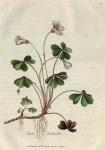
 Synonyma. Lujula. Pharm. Lond.
Synonyma. Lujula. Pharm. Lond.
Oxalis Acetosella, scapis unifloris, fol. ternatis: foliolis obcordatis pilosis. Thunb. Diss. de Oxal. n. 5. Curtis Flor. Lond. Withering's Bot. Arrang. p. 470. Relhans Flor. Cant. p. 176.
Oxys scapo unifloro, foliis ternatis, radice squamoso-articulata. Hal. Stirp. Helv. n. 928.
Oxys sive Trifolium acidum, flore albo & purpurascente. J. Bauh. II. 387.
Trifolium acetosum vulgare. Bauh. Pin. 330. Parkinson & Theat. 746.
Oxys Alba. Gerard. Herb. 1201. Raii Synop. p. 281.
Wood-Sorrel. Hist. Plant. 1098.
Acetosella, et Alleluja, Quorundam.
Class Decandria. Ord. Pentagynia. L. Gen. Plant. 582.
Ess. Gen. Ch. Cal. 5-phyllus. Petala unguibus connexa. Caps. angulis dehiscens, 5-gona.
Spec. Char. O. scapo unifloro, foliis ternatis obcordatis, radice dentata. L. Syst. ed. 13.
This delicate little plant is excellently described by Mr. Curtis, (Flor. Lon.) we shall therefore adopt his description, as far as it coincides with our plan. The root is perennial, horizontal, scaly, and of a bright red colour; the leaves grow three together, inversely heart-shaped, of a yellowish green colour, frequently purple underneath, and beset with a few hairs; the leaf stalks are about three inches long, nearly upright, tender, proceeding from little bulbs, which form a kind of sheath, at the bottom these stalks are red and round, but towards the top grooved on one side: the flowers are white or flesh-coloured, and elegantly streaked with red veins. The flower-stalk is somewhat longer than the leaf-stalk, and furnished near the top with two oval pointed bracteae, which partly surround it; the calyx is divided into five segments; these are short, permanent, bluntish, membraneous at the edges, and often spotted with purple; the petals are five, affixed to the receptacle by the claws, which bend a little inward just above where the claws adhere together, they are blunt, slightly crenated, and tinged at the bottom with yellow; the stamina are ten, upright, white, the five exterior the shortest; the antherae are yellow and bilocular; the germen is quadrangular and green; the styles are five, very slender, a little longer than the stamina, and the stigma is blunt; the capsule is ovalish, pentagonal, spotted, divided into five cavities, each containing three seeds, which are heart-shaped, longitudinally grooved, convex on both sides, of a bright reddish brown colour, and inclosed within a shining white elastic arillus, by the bursting of which the seeds are thrown out. [As a distinguishing part of the generic character, Ray says, "Quod per maturitatem levi tactu dissiliens cum impetu semina ejaculantur, (hist. 1098).] This plant is a native of England, it flowers about April and May, and is commonly found in woods, or in shaded situations. [Mr. Curtis observes, that this plant continues to produce seeds during the greatest part of the summer, without any appearance of expanded blossoms.]
The Acetosella is totally inodorous, but has a grateful acid taste, [This makes it useful in sallads, in some measure supplying the place of vinegar.] which is more agreeable than the common sorrel, (Rumex Acetosa) and approaches nearly to that of the juice of lemons, or the acid of tartar, with which it also corresponds in a great measure in its medical effects, being esteemed refrigerant, antiscorbutic, and diuretic. It is recommended by Bergius in inflammatory, bilious, and putrid fevers, and from the cases adduced by Francus, [De vera herba Antiquorum Acetosella, &c.] he concludes, "Acetossellam appetitum restaurare, vomitum consopire, alvum stringere, sitim sedare, oris amaritiem tollere, cordis vires reparare, anginamque abigere." [Mat, Med, p. 379.] The principal use however of the Acetosella is to allay inordinate heat, and to quench thirst; for this purpose, a pleasant whey may be formed by boiling the plant in milk, which under certain circumstances may be preferable to the conserve directed by the London College, though an extremely grateful and useful medicine. Many have employed the root of Lujula, probably on account of its beautiful red colour rather than for its superior efficacy. An essential salt is prepared from this plant, known by the name of Essential Salt of Lemons, and commonly used for taking ink-stains out of linen. [This salt is made from the expressed juice. Vide Boerh. Chem. vol. 2. proc 7. & Savary, Diss. de Sale Essent. Acetosellae. p. 9. Thunberg found that the Oxalis cernua of the Cape of Good Hope, yields the salt in greater quantity than the Acetosella. — This salt, when genuine, which is seldom to be procured so, [Vide Scheele in Görwells nya tidningar, 1775. n. 30. p. 237. & Savary, l. c. What is sold under the name of Essential Salt of Lemons in this country, appears sometimes to consist of C. Tart, with the addition of a small quantity of vitriolic acid. MS. Lectures on Chemistry by Dr. Hamilton.] is composed of the vegetable alkali and a peculiar acid, which seems more allied to the acid of sugar than that of tartar. Vide Bergman Act. Up. Nov. vol. 2. p. 215. where the manner of separating this acid is also given, and related by Murray. Ap. Med. vol. 3. p. 497.]

